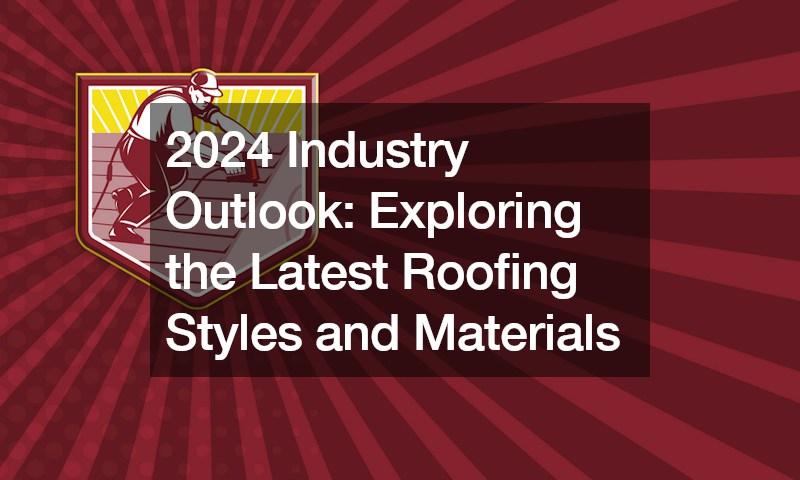Most of us have heard the phrase “roof over your head” countless times. It’s just a few words used to describe how lucky we are to have shelter. Unless you’re a roofer who knows the protection that a solid and sturdy roof provides. For the rest of us, the roof is just there, out of sight. That is until it begins to leak, or a fierce storm carries it away, and our world is thrown into chaos.
It’s then that we realize not only is having a roof over our heads important, but making sure that the roof is sturdy, made from good materials, and fits our needs is just as critical. We’ve evolved greatly as a civilization regarding how we shelter ourselves from the elements. The first known roofing materials were made from animal parts, clay, mud, palm leaves, straw, and other plant life.
As time went on, people began using wood, tin, and copper. While all the materials were ingenious at the time, proving that necessity is indeed the mother of invention, they didn’t always work out well. As you can imagine, the roofs were leaky, there was not much protection from brutal weather, and in the case of tin roofs, it could be extremely hot.
Often, they were downright dangerous, as in the case of thatched roofs, which were popular in England for a time. Thatched roofs seemed like a great idea, made from dried plant material and tightly woven together, then using sod for insulation. However, when they were found to catch on fire easily, the country outlawed them.
This led us into the 20th century when some very bright people discovered using asphalt could be the solution to all our roofing needs. Enter 2024, technology and science have afforded us choices about how we protect ourselves and our possessions. We have more resources than ever, from solar panels that are energy efficient and save us money to Spanish barrel tiles that can give an average home the look of an exotic Villa. This blog will explore these roofing styles as well as others to help you stay current on the latest roofing styles, so you won’t be left out in the cold.

1. Metal Roofing
You may think of metal roofing as something that’s only installed on industrial buildings or farm structures. The truth is, more and more homeowners are opting for this material; in fact, it’s becoming one of the latest roofing styles. A metal roof could be made from steel, aluminum, copper, tin, or a combination of both.
An experienced metal roofing contractor can give the roof the appearance of shingles, tiles, panels, and even shakes. There are many benefits to using metal for your roof, especially if you live in areas affected by extreme weather and natural disasters. Most metal roofs can withstand winds of up to 160 miles per hour.
They are impact and fire resistance, something to think about if you live near areas that are prone to wildfires, tornadoes, and hurricanes. Heavy snowfall will easily fall off metal roofs, especially when the frame or roof metal decking is installed correctly. This type of roof is economical as well.
It is excellent at reflecting the sun’s rays and can help reduce cooling costs by up to 25%. Metal roofs are also environmentally friendly as anywhere from 25% to 95% of them may come from recycled materials. According to many local roofing contractors, a metal roof will last anywhere from 40 to 70 years, which is not a bad return on your investment. There are a few drawbacks to having a metal roof: they can be noisy when it rains and are often more expensive to install.

2. Asphalt Shingles
These little squares of petroleum mixed with sand, gravel, and crushed stone sometimes get a bad rap. In the past, asphalt roofs have been unattractive, unreliable, and generally underperforming for many homeowners and roofers alike. Nonetheless, it has remained a top choice for roofing in North America.
With technological advances, the good news is that asphalt is no longer the same as what was slapped on your parent’s roof. It’s easy to install, so it’s a favorite of most residential roof installers. The fact that it’s a familiar favorite makes it less expensive than other materials.
Asphalt comes in many shapes, sizes, and colors. You can even use asphalt that looks like slate or Cedar shake. This versatility makes it easy to fit any roof style and home design. It’s also much easier to do solar and gutter installation. Depending on your budget, there are different degrees of asphalt available. While it’s all fire-resistant, you can choose different levels of protection based on the area in which you live.
Most asphalt roofs do a great job of preventing fire penetration and containing the spread. Another plus for asphalt roofs is their thick underlayer, which provides excellent insulation and can cut energy costs. One drawback to an asphalt roof is that it tends not to last as long as other types of roofs. Depending on what the weather is like where you live, an asphalt roof may last between 15 and 20 years.
3. Composite Slate Tile
If you’re looking for the utmost in upscale curb appeal, a slate roof can help in that department. Slate is a smooth rock mined in Italy, Portugal, Brazil, and parts of the Eastern United States. Be forewarned, it’s expensive. In fact, it’s four times more costly than asphalt.
Slate has a reputation for cracking easily and is hard to replace. While it does need to be maintained regularly, slate is durable and very sturdy. It’s relatively easy to replace a few tiles, and most people keep a spare box just in case.
You will need roof coating contractors to “flash” the slate roof to protect it. The coating goes on wet and, as it dries, forms an elasticized seal. If you properly maintain a skate roof, it can last more than 50 years.
Some homes have slate roofs that are close to one hundred years old. Slate offers excellent insulation and can help you save on heating and air conditioning costs. However, your home needs to be framed so that it can support the weight of the slate. It’s recommended that you meet with a structural engineer before deciding. Don’t fret, though; many asphalt companies are now making shingles that mimic the beauty of slate without the weight or cost.
4. Wind Vented Roof
Most of us have probably noticed those little bubbles on top of some buildings that resemble mini skylights. If you’ve ever wondered what they are, you’re in luck. The small plastic constructs are part of a wind-vented roof system. This type of roof is most often used on commercial buildings and other large buildings to protect the property.
A vented roof harnesses the power of the wind to hold the roof in place. It’s based on the scientific principle “the Venti effect,” in which the wind flows through the vents and creates a vacuum effect. As the wind increases, it gets pulled under the roof decking and secures the roof. Basically, the stronger the winds, the stronger the roof.
The best part of this system is there’s no need to tear off an existing roof entirely. It’s also compatible with most roofing materials. A wind vent system also helps to keep moisture off and out of the roof, which will help prolong its life and prevent leaks.

5. Grass/Green Roofing
Can you imagine being able to pick Oregeno off your roof? With a green roof, you can do that and more. Green roofs are also known as grass roofs and living roofs. They’ve been gaining popularity with many eco-conscious people, as well as those who don’t have space for a garden.
Green roofs are nothing new. If you’ve ever heard of the Hanging Gardens of Babylon from ancient lore, it was a green roof. Contrary to what you may think, a living roof is extremely sturdy and great for insulation. That’s because multiple layers include the roof decking, vapor barrier, thermal insulation, root barrier, and drainage system.
Depending on the size and intricacy of the roof you can grow a variety of grasses, moss, succulents, herbs, wildflowers, shrubs, and bushes. Other than weeding and fertilizing the roof, they require very little maintenance. A green roof provides heat reduction and fabulous insulation. They also help provide clean air and noise reduction. The average green roof can last 40 to 50 years. The only cons are that they are pretty expensive to install and may not do well in colder climates.
6. Cedar Shake Shingles
Cedar shake shingles are great if you’re going for rustic, natural beauty. The cedar planks are hand-split and carved, so no two are alike. This gives each Cedar Shake roof a unique appearance. Natural wood provides excellent insulation and is energy efficient, saving you money in the long run.
The long run is critical for this material because sourcing and production are expensive, which is passed on to the customer. Cedar shake performs well against high winds, hail, heavy rain, and snow. They don’t typically get weathered or crack easily.
One thing to consider is maintenance. You will need to have the roof inspected every 2 to 3 years to make sure no planks are loose or missing. Being that it is made of wood, it can attract bugs, so if your roof is damaged, insects can invade your house. The average Cedar shake roof lasts about 60 years.

7. Clay Roofing
No list of roofing materials would be complete without clay. Most of us have seen these classic reddish-orange house toppers. They give all types of homes, from mansions to bungalows, an old-world look. Like something from a Hollywood movie, a clay roof will make your home stand out and enhance the curb appeal.
The tiles come in many shapes, like barrel, flat, French, and Spanish. You can also choose colors ranging from a light orange to a deep red. But it’s still a roof with the primary purpose of protecting you and your possessions, so what about the non-aesthetics? Clay roofs do well in all climates and withstand heavy rainfall, snow, high winds, and intense sunlight.
The tiles are naturally fire-resistant and can last up to 100 years. There’s no danger of rot, decay, or insect infestation. Clay tiles are an excellent source of insulation and provide a cooling effect that will cut down on air conditioning costs.
No roofing material is perfect; however, clay roofs are known to be brittle, so installing them requires a roofing professional with experience handling clay tiles. Another thing to consider is, since they are more fragile than other materials, falling debris, trees, and hail can cause damage. Clay tiles are expensive, so if they break or crack, it will be costly to replace them.
8. Synthetic Roofing
This polyurethane material is taking the roofing world by storm. Made primarily from recycled plastic and rubber, synthetic roofs are perfect for people on a budget who live in four-season climates. The material can mimic just about any other type of roof design and material, including slate, cedar, and clay.
Synthetic roofs are lightweight but provide good insulation and are fire-resistant. They don’t crack, tear, or split and can sustain winds up to 110 miles per hour. Synthetic roof materials don’t warp easily or mold, and you won’t see any unsightly algae growing on the top of your home. Most roofs made of this material last between 30 and 50 years.
As you can see, 2024 brings many choices regarding roofing styles and the materials used to install them. It’s all a matter of deciding on a budget, choosing the style that suits your needs, and finding a roofing company you’re comfortable working with. Be sure that you consider all the variables like the climate in which you live, price, durability, and efficiency. But don’t sacrifice style for practicality either. Working with an experienced, local roofer can help you find a design that fits your lifestyle.




Leave a Reply